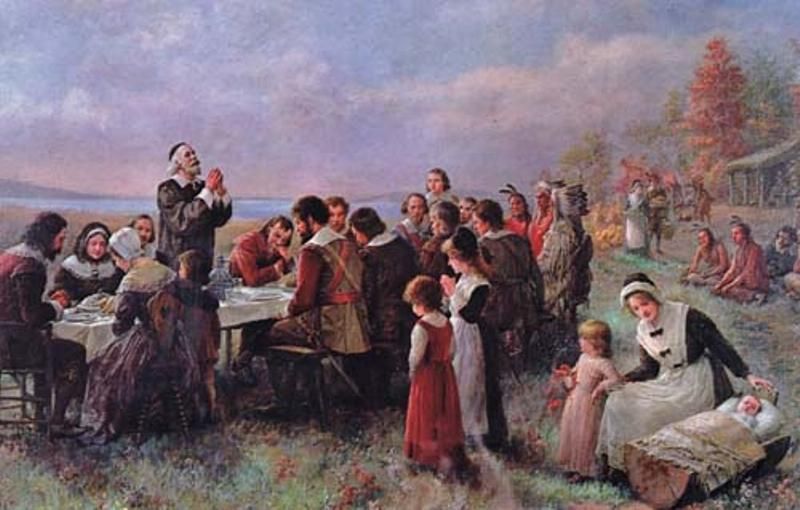- Hi Kid
- Posts
- Thanksgiving...A Day To Mourn.
Thanksgiving...A Day To Mourn.
Thanksgiving-a Day to Mourn or a Day to be Grateful?
Is Thanksgiving a day Americans should celebrate the blessings in their lives or is Thanksgiving better commemorated by mourning and thoughts of betrayal, destruction, and oppression?
What should local students be taught about Thanksgiving? What should we all know about this uniquely American holiday?
Poudre School District recommends a variety of resources for teachers to incorporate in their Thanksgiving lessons through PSD’s DEI Inclusive Calendar and Events.
We were interested to realize many of the PSD recommended links focus on negative messages and highlight Thanksgiving as a bitter day of mourning. One such resource is a tumblr post from 2011 titled, “Deconstructing the Myths of the First Thanksgiving”. In that post, “Thanksgiving is a happy time," is listed as myth number 11.
Fact: For many Indian people, “Thanksgiving” is a time of mourning, of remembering how a gift of generosity was rewarded by theft of land and seed corn, extermination of many from disease and gun, and near total destruction of many more from forced assimilation. As currently celebrated in this country, “Thanksgiving” is a bitter reminder of 500 years of betrayal returned for friendship.
Other PSD recommended links lead to the United American Indians of New England National Day of Mourning homepage. The UAINE hold an annual rally in Plymouth, Massachusetts to commemorate a National Day of Mourning on Thanksgiving Day to honor native cultures and to protest against racism and oppression experienced by Indigenous people worldwide.
The poster advertising the UAINE National Day of Mourning demands participants...
"Help shatter the untrue image of the Pilgrims and the unjust system...that they and other European settlers introduced to these shores."
United American Indians of New England National Day of Mourning 2023 advertisement.
What Should Your Children Learn?
So what should PSD students be taught about Thanksgiving? Should they learn that the Pilgrims and European settlers who founded the United States created a bigoted, sexist, unjust country? Or should they learn the fascinating and nuanced history of the Thanksgiving holiday?
Should students learn, as Melanie Kirkpatrick states in her 2016 book, Thanksgiving: The Holiday at the Heart of the American Experience that:
"...the American Thanksgiving is far more than an update of an ancient harvest festival. Thanksgiving has grown up with the country. It reflects our national identity as a grateful, generous and inclusive people. When a twenty-first-century American takes his place at the Thanksgiving table or volunteers at a local food bank, he is part of a continuum that dates back to 1621, when the Pilgrims and the Indians shared their famous three-day feast."
Should students learn the amazing story of the women's rights advocate Sarah Josepha Hale who pursued the establishment of Thanksgiving as a national holiday for decades? Hale was an unexpected widower who became an author, an editor of a national magazine, an abolitionist, and a fierce advocate for equal education, equal economic rights, and equal professional opportunity for women. Hale used her position as the editor of the wildly popular Godey's Lady's Book magazine during and after the Civil War to consistently petition significant political leaders to establish a National Day of Thanksgiving. She believed in the unifying power of Thanksgiving and wrote in 1859,
"...would it not be a renewed pledge of love and loyalty to the Constitution of the United States, which guarantees peace, prosperity, progress, and perpetuity to our great Republic?"
Should students learn that the traditional depiction of the first Thanksgiving with the Pilgrims and Indians is often historically inaccurate, as in the famous painting below? Pilgrims did not dress in the drab colors in which they are painted and the Indians shown wearing feathers which would be more accurate for Great Plains Indians. But the imagery captured by the painting does accurately capture the spirit of Thanksgiving-that of expressing gratitude.

The First Thanksgiving at Plymouth by Jennie Brownscombe, 1914.
Should students learn about the first national Thanksgiving proclamation issued on October 3, 1789, by George Washington? At the urging of Congress, Washington issued a proclamation to the Governors of all the states requesting that they recommend to their citizens that the people of the United States recognize a day of Thanksgiving. Washington was aware of the precedence he established with his proclamation and was careful to ensure his statements were religiously inclusive and did not refer to any specific religion. Washington's tone has been continued through the centuries and Presidential Thanksgiving proclamations generally follow the same messaging--expressing gratitude to God for abundant blessings and giving thanks for the unique American civic and religious freedoms. Washington recommended:
"...to the People of the United States a day of public thanksgiving and prayer to be observed by acknowledging with grateful hearts the many signal favors of the Almighty God, especially by affording them an opportunity peaceably to establish a form of government for their safety and happiness."
What Should You Do?
We wonder the extent to which most of us understand the history behind this uniquely American holiday. Would all of our holidays be enriched if we knew the extensive history of Thanksgiving? How can we know what our children should be taught about Thanksgiving, if we ourselves are ignorant?
Ask your children what they are taught about Thanksgiving.
Click on the links embedded above and learn more about Thanksgiving.
Read Melanie Kirkpatrick's book Thanksgiving: The Holiday at the Heart of the American Experience
Ask your teachers and administrators what they teach their students about Thanksgiving.